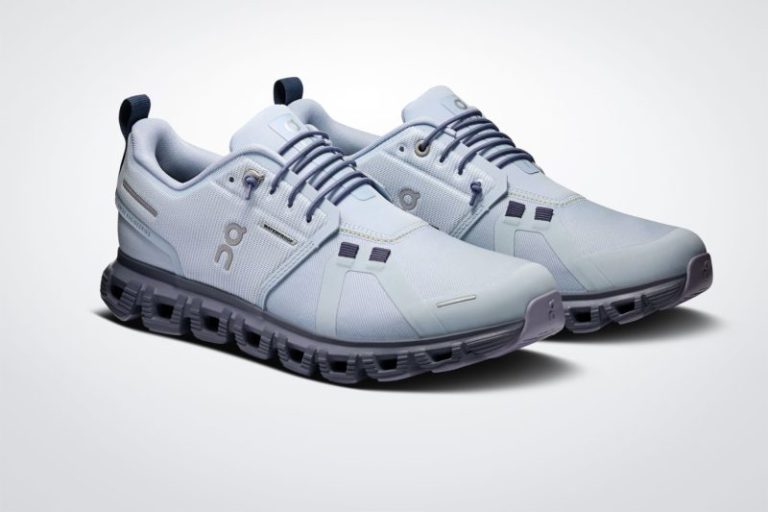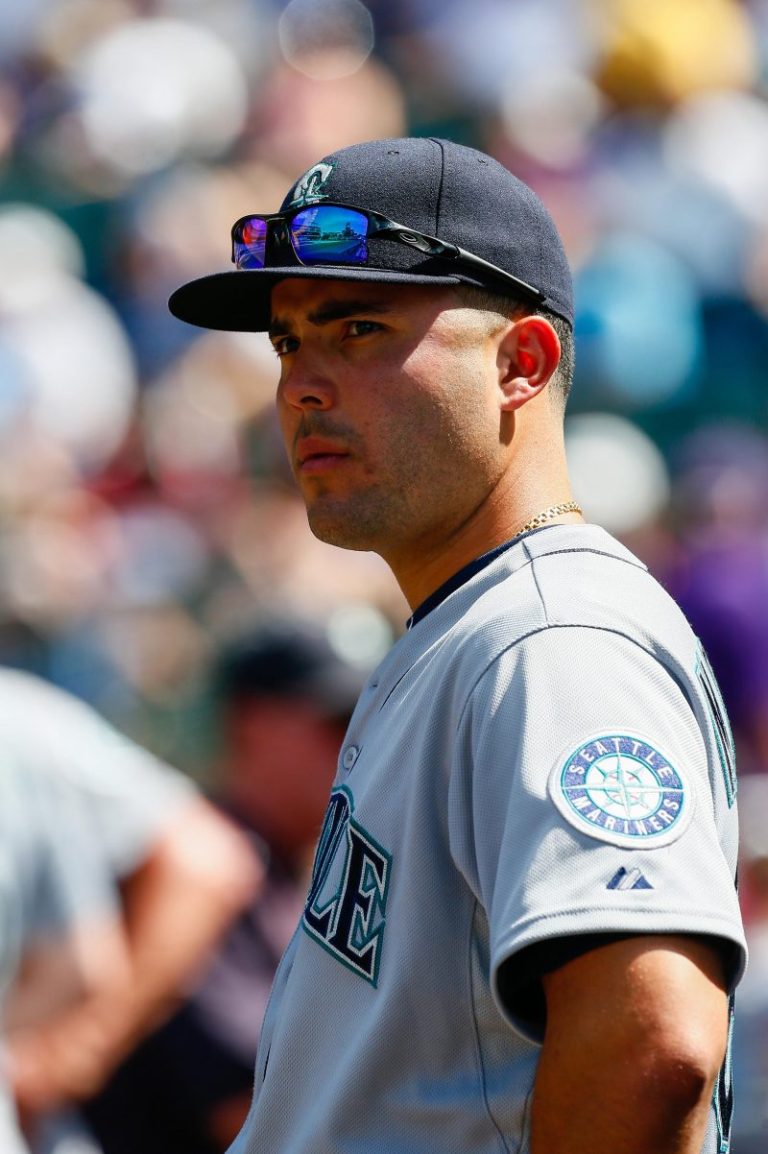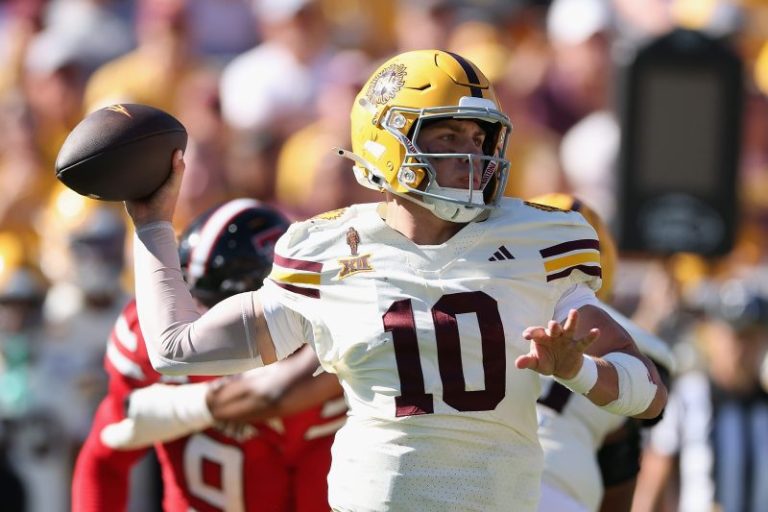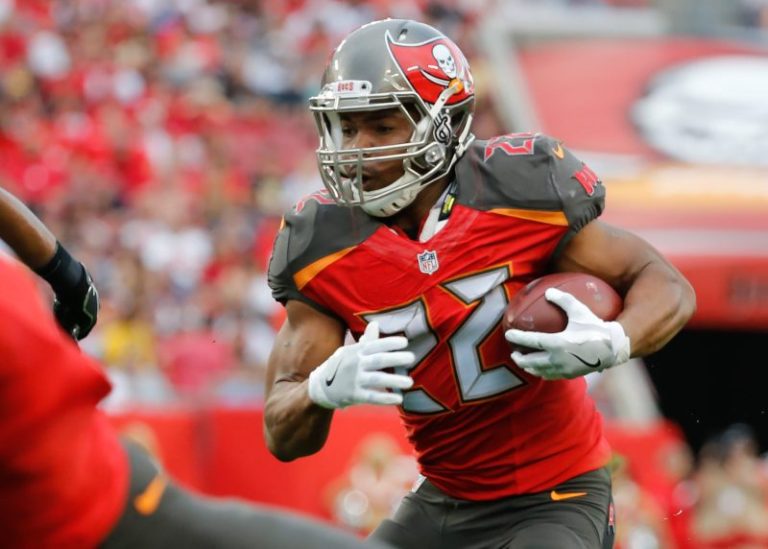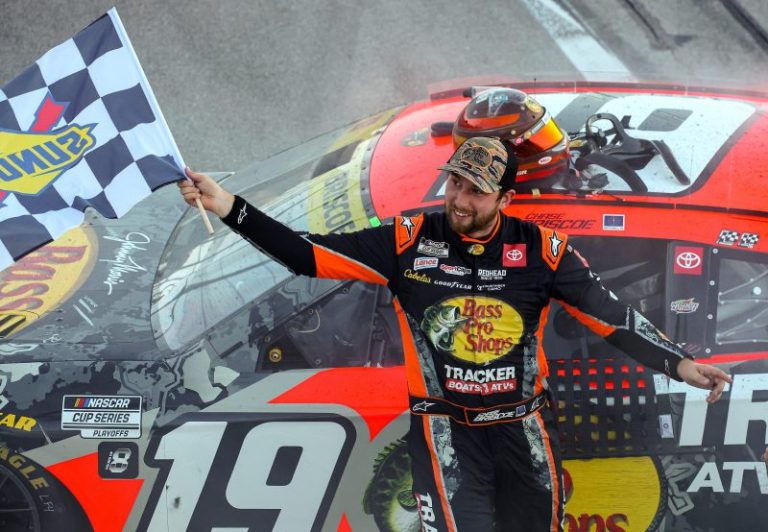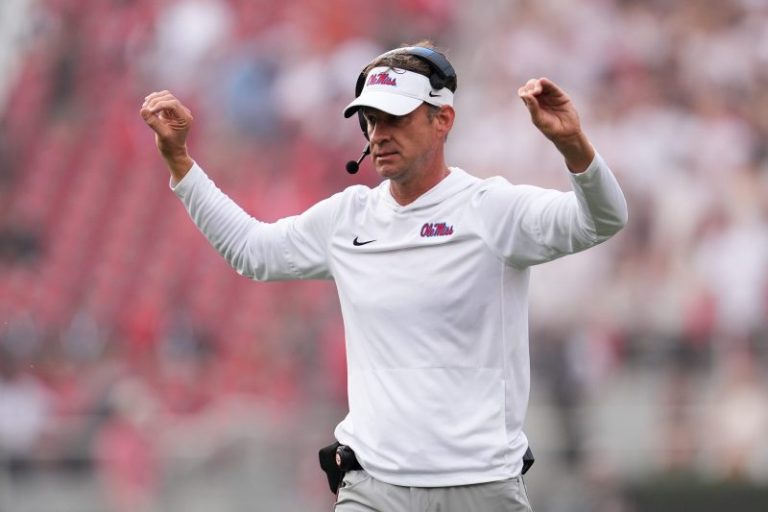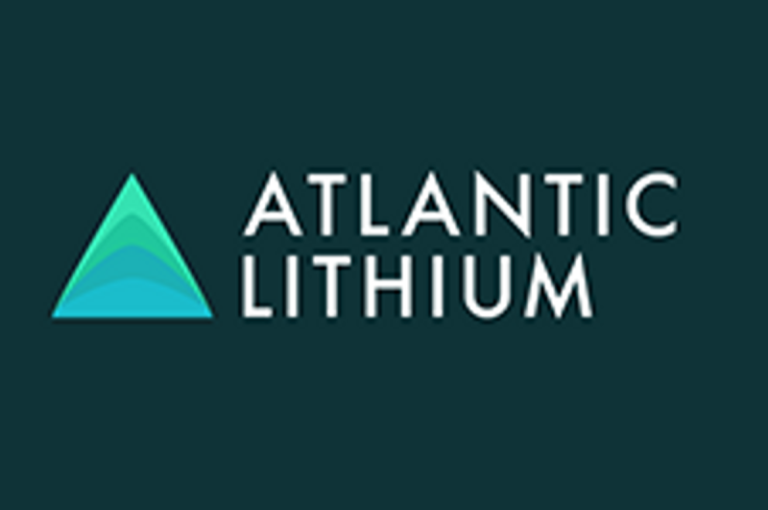Chase Briscoe will race for his first NASCAR Cup Series championship after winning the NASCAR Cup Series playoff race at Talladega Superspeedway on Sunday, Oct. 19.
Briscoe shot to the lead in his No. 19 Toyota in the final lap of overtime in the YellaWood 500 and held off Front Row Motorsports’ Todd Gilliland and Ty Gibbs – who were both seeking their first career Cup Series victories – at the checkered flag.
Briscoe’s win in the second race of the Round of 8 assured him of a spot in the Championship Race in just his first season at Joe Gibbs Racing. He joins JGR teammate Denny Hamlin in the final four, leaving the remaining two title hopefuls to be decided at Martinsville Speedway next weekend.
‘I don’t know what’s more unbelievable – the fact that we’re going to the Championship 4 or that I won a superspeedway race,’ Briscoe said. ‘What an amazing day.
‘I can’t thank Ty Gibbs enough. He was an incredible teammate there at the end. Honestly, it was just so selfless. He could’ve easily tried to make a move to try and win the race and he pushed me to the win.’
When the green flag flew for the two-lap overtime shootout, it appeared a Hendrick Motorsports car would capture the win at NASCAR’s largest track. Playoff drivers William Byron and Kyle Larson led the field and battled side-by-side before Larson pulled in front of his teammate. But then Larson’s No. 5 Chevrolet ran out of gas, forcing Byron to check up. As Bryon tried to regather his No. 24 Chevy to battle for the win, he was hit from behind in the tri-oval by Carson Hocevar, sending Byron spinning all the way out of the top 20.
“Certainly, a finish would have helped us be a little bit closer on the points side of things,” said Byron, who ultimately finished 25th. “We just lost control of the race. We just couldn’t get the pushes going the way we needed to on the bottom lane.”
Larson finished 26th, one spot behind Byron.
Briscoe took advantage of the Hendrick drivers’ misfortune for his third win of the season and the fifth of his Cup career. His teammate Christopher Bell also finished in the top 10, putting JGR in position to possibly send three drivers to the Championship 4 in two weeks at Phoenix Raceway.
Meanwhile, another championship hopeful from Hendrick Motorsports was knocked out of the race before Stage 1 ended. Chase Elliott was caught up in a multicar crash with a handful of laps remaining in the opening stage, with his No. 9 Chevy suffering major damage that could not be repaired. He now faces a must-win situation at Martinsville to make the Championship 4.
Team Penske’s Joey Logano and Ryan Blaney looked strong for much of the race, but the playoff drivers were forced to pit for fuel before overtime began, taking them out of contention. Logano finished 16th and Blaney 23rd.
Updated NASCAR playoff standings
With just one race remaining before the NASCAR Championship Race at Phoenix Raceway on Nov. 2, here are the updated playoff standings following the YellaWood 500:
- Chase Briscoe, Joe Gibbs Racing … Clinched berth in Championship 4
- Denny Hamlin, Joe Gibbs Racing … Clinched berth in Championship 4
- Christopher Bell, Joe Gibbs Racing … +37 points
- Kyle Larson, Hendrick Motorsports … +36
- William Byron, Hendrick Motorsports … -36 points
- Joey Logano, Team Penske … -38
- Ryan Blaney, Team Penske … -47
- Chase, Elliott, Hendrick Motorsports … -62
NASCAR Talladadega extended highlights
Chase Briscoe wins at Talladega to make NASCAR Championship 4
Chase Briscoe drove his No. 19 Joe Gibbs Racing Toyota to the front of the pack in overtime and outdueled Todd Gilliland and Ty Gibbs to win the YellaWood 500 at Talladega Superspeedway. With the win, Briscoe clinched a spot in the 2025 NASCAR Cup Series championship race, joining his JGR teammate Denny Hamlin, who won last weekend at Las Vegas.
Chris Buescher brings out caution, sends race to overtime
Chris Buescher got hit from behind while leading and swerved in front of the field and into the inside wall to bring out the caution in the YellaWood 500 at Talladega Superspeedway. Buescher was leading William Byron, who got shoved from behind by Carson Hocevar and into Buescher to send the No. 17 RFK Racing Ford across the track.
Team Penske playoff drivers Joey Logano and Ryan Blaney were forced to come down pit road because neither had enough fuel to complete overtime.
Talladega playoff race: Lap 150 update
Reigning series champion Joey Logano leads the field with 38 laps to go in the YellaWood 500 at Talladega Superspeedway. Logano is getting a strong push from Team Penske teammate Ryan Blaney, a fellow playoff driver. Ross Chastain, Michael McDowell and Brad Keselowski also race in the top five.
Chase Briscoe wins Stage 2 of Talladega playoff race
Playoff drivers took four of the top five spots in Stage 2, with Joe Gibbs Racing’s Chase Briscoe winning the second segment over Hendrick Motorsports driver Kyle Larson. Carson Hocevar finished third, the only non-playoff driver in the top three. Hendrick Motorsports’ William Byron finished fourth, followed by JGR’s Christopher Bell. Ty Gibbs, Ryan Blaney, Todd Gilliland, John Hunter Nemechek and Alex Bowman rounded out the top 10.
Talladega playoff race: Lap 90 update
Hendrick Motorsports drivers have not made much of an impact through 90 laps of the Yellawood 500, whether by strategy to ride in the back for the first half of the race or because their Chevrolets are not as fast as other cars in the field.
Meanwhile, the Team Penske Fords of Joey Logano and Ryan Penske have been able to drive through the field and are back near the front of the pack – the only playoff drivers currently in the Top 10.
Ty Gibbs wins Stage 1 of Talladega playoff race
Ty Gibbs edged fellow Toyota driver Tyler Reddick by a nose to win the opening stage of the YellaWood 500 at Talladega Superspeedway. John Hunter Nemechek finished third, followed by playoff driver Ryan Blaney in fourth and Bubba Wallace in fifth. Joey Logano, seeking his second consecutive series championshp, finished sixth, with Zane Smith, Michael McDowell, Carson Hocevar and playoff driver Christopher Bell rounding out the Top 10.
Chase Elliott knocked out of Talladega race
Chase Elliott’s day at Talladega ended before Stage 1 after his No. 9 Hendrick Motorsports Chevrolet suffered catastrophic damage during a multicar crash on Lap 53. Elliott now heads to next week’s playoff race at Martinsville Speeday at a huge points disadvantage and could be facing a must-win situation to make the championship race in two weeks.
Big crash takes out a number of cars, including Elliott
Erik Jones pushed leader Noah Gragson, trying to propel him forward on the outside in Turn 3, but the contact turned Gragson into inside lane leader AJ Allmendinger, triggering a multicar wreck on Lap 53. A number of cars suffered massive damage, with Allmendinger having to be helped out of the car and into the safety crew vehicle transporting him to the infield care center.
Playoff driver Chase Elliott was among the drivers involved, with his No. 9 car suffering big damage. Austin Cindric, Austin Dillon, Justin Haley and Ricky Stenhouse Jr. also got collected in the incident.
Cars make green flag pit stops in Stage 1
Drivers began green-flag pit stops during Stage 1 of the YellaWood 500, coming in for fuel starting with about 20 laps to go. Three drivers were penalized for speeding: Kyle Busch, Ross Chastain and playoff driver Chase Briscoe. All three had to come back down pit road to serve pass-thru penalties.
NASCAR Talladega race: Lap 20 update
Drivers had immediately made the race three-wide when the green flag flew, but after 20 laps, the race has settled down to two packs driving two-wide. Kyle Busch leads with Shane van Gisbergen, Justin Haley, Bubba Wallace, Christopher Bell, Josh Berry and Chase Briscoe rounding out the top 7.
Green flag waves for NASCAR playoff race at Talladega
Michael McDowell and Chase Briscoe lead the field as the green flag waves for the YellaWood 500 at Talladega Superspeedway. The opening stage is 60 laps.
When is the green flag for NASCAR playoff race at Talladega?
The green flag for the YellaWood 500 is expected to drop at 2:28 p.m. ET (1:28 p.m. local), per Fox Sports’ Bob Pockrass after some track drying earlier today.
What time does the NASCAR playoff race at Talladega start?
The YellaWood 500 is scheduled to start at 2 p.m. ET on Sunday, Oct. 19 at Talladega Superspeedway in Talladega, Alabama.
What TV channel is the NASCAR playoff race at Talladega?
The YellaWood 500 will be broadcast on NBC, the home of the Cup Series’ final three races of the season. Pre-race coverage will start at 1:30 p.m. ET.
Will there be a live stream of the NASCAR playoff race at Talladega?
Yes, the YellaWood 500 will be streamed on Peacock, Sling TV and Fubo, which is offering a free trial to new subscribers.
Stream the NASCAR race at Talladega on Fubo
Who is on the pole for NASCAR playoff race at Talladega?
Michael McDowell won the pole for today’s YellaWood 500 at Talladega. Playoff driver Chase Briscoe will start alongside on the front row.
How many laps is the NASCAR playoff race at Talladega?
The YellaWood 500 is 188 laps around the 2.66-mile track for a total of 500.08 miles. The race will have three segments (laps per stage) — Stage 1: 60 laps; Stage 2: 60 laps; Stage 3: 68 laps.
NASCAR Cup Series playoff standings
Here’s how things look as the playoff field hits the second race in the Round of 8. The bottom four drivers will be eliminated after Martinsville.
- Denny Hamlin
- Kyle Larson (+4)
- Christopher Bell (+19)
- Chase Briscoe (+24)
- William Byron (+39)
- Chase Elliott (+47)
- Joey Logano (+48)
- Ryan Blaney (+55)
Who won the NASCAR playoff race at Talladega last year?
Last year’s YellaWood 500 featured one of the closest finishes of the year. Ricky Stenhouse Jr. earned his lone win of the season by 0.006 seconds over Brad Keselowski. The No. 47 Chevrolet driver ended his win drought on a superspeedway after previously winning the 2023 Daytona 500. William Byron’s push on the final lap got Stenhouse Jr. ahead of Keselowski to cause a bit of chaos in the Round of 12. Stenhouse Jr. led a total of 19 laps in a race affected by a massive wreck with five laps remaining. With 28 cars involved, it was the biggest Cup Series wreck since 2002. Keselowski, Byron, Kyle Larson and Erik Jones rounded out the top five runners.
What is the lineup for the YellaWood 500 at Talladega?
- Michael McDowell, No. 71 Spire Motorsports Chevrolet
- Chase Briscoe, No. 19 Joe Gibbs Racing Toyota
- Kyle Busch, No. 8 Richard Childress Racing Chevrolet
- Austin Cindric, No. 2 Team Penske Ford
- Ryan Preece, No. 60 Roush Fenway Keselowski Racing Ford
- Josh Berry, No. 21 Wood Brothers Racing Ford
- Christopher Bell, No. 20 Joe Gibbs Racing Toyota
- Ryan Blaney, No. 12 Team Penske Ford
- Riley Herbst, No. 35 23XI Racing Toyota
- Bubba Wallace, No. 23 23XI Racing Toyota
- Alex Bowman, No. 48 Hendrick Motorsports Chevrolet
- Cole Custer, No. 41 Haas Factory Team Ford
- William Byron, No. 24 Hendrick Motorsports Chevrolet
- Chris Buescher, No. 17 Roush Fenway Keselowski Racing Ford
- Tyler Reddick, No. 45 23XI Racing Toyota
- Joey Logano, No. 22 Team Penske Ford
- Denny Hamlin, No. 11 Joe Gibbs Racing Toyota
- Ty Gibbs, No. 54 Joe Gibbs Racing Toyota
- Kyle Larson, No. 5 Hendrick Motorsports Chevrolet
- Brad Keselowski, No. 6 Roush Fenway Keselowski Racing Ford
- Austin Dillon, No. 3 Richard Childress Racing Chevrolet
- Justin Haley, No. 7 Spire Motorsports Chevrolet
- Zane Smith, No. 38 Front Row Motorsports Ford
- Ross Chastain, No. 1 Trackhouse Racing Chevrolet
- Chase Elliott, No. 9 Hendrick Motorsports Chevrolet
- Daniel Suarez, No. 99 Trackhouse Racing Chevrolet
- Todd Gilliland, No. 34 Front Row Motorsports Ford
- John Hunter Nemechek, No. 42 Legacy Motor Club Toyota
- Ty Dillon, No. 10 Kaulig Racing Chevrolet
- Erik Jones, No. 43 Legacy Motor Club Toyota
- Shane van Gisbergen, No. 88 Trackhouse Racing Chevrolet
- Carson Hocevar, No. 77 Spire Motorsports Chevrolet
- Austin Hill, No. 33 Richard Childress Racing Chevrolet
- AJ Allmendinger, No. 16 Kaulig Racing Chevrolet
- Cody Ware, No. 51 Rick Ware Racing Ford
- Noah Gragson, No. 4 Front Row Motorsports Ford
- Ricky Stenhouse Jr., No. 47 HYAK Motorsports Chevrolet
- Anthony Alfredo, No. 62 Beard Motorsports Chevrolet
- BJ McLeod, No. 78 Live Fast Motorsports Chevrolet
- Casey Mears, No. 66 Garage 66 Ford
The USA TODAY app gets you to the heart of the news — fast. Download for award-winning coverage, crosswords, audio storytelling, the eNewspaper and more.
This post appeared first on USA TODAY

